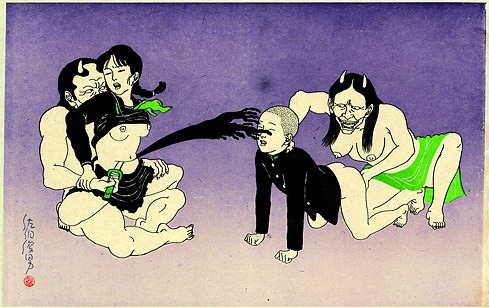WARNING: THIS POST CONTAINS MATERIAL THAT VIEWERS MAY FIND GRAPHIC AND DISTURBING.
While reading through the January/February issue of HorrorHound Magazine, I found a little gem on page 29 that really caught my eye.
 |
| “Cannibal Man’s Dessert” by Shintaro Kago |
What first attracted me to the article was a photo of various toys/figurines of dismembered and disfigured human bodies, so I read the feature above it, titled “Ero-Guro Toys”.
The article was about famed artist Shintaro Kago. Kago is known mostly for his manga, which features gore, sex and lots of blood. His style is known as “Ero-Guro”, a term that means “Erotic Grotesque”.
I had never heard of this art form previous to reading the article, so I immediately Google searched it.
As it turns out, Ero-Guro has been around since the mid-1860s in Japan. Its earliest roots were in the form of “woodblock printings showing decapitations and acts of violence from Japanese history. Ukiyo-e artists such as Utagawa Kuniyoshi presented similar themes with bondage, rape, and erotic crucifixion.” (via Wikipedia)
During the 1920s and 1930s, Ero-Guro really took shape in Japanese culture. One of the most influential events in the history of Ero-Guro art is The Sada Abe Incident of 1936, during which a woman strangled and castrated her lover.
The sub-culture was brought almost to a complete halt during the World War II era, but re-emerged stronger than ever in postwar Japan.
In later years, Ero-Guro would expand its blood-soaked, presumably sawed off arms to the realms of theater, film, and soft-core Japanese porn known as pinku eiga.
Edogawa Rampo, a Japanese author, also helped open the gateway for Ero-Guru with his novels that often featured strange or erotic themes (sometimes referred to as “nonsense” literature) which would go on to influence Ero-Guro films based on his work.
During the late 60’s and early 70’s, Ero-Guro films such as Shogun's Joys of Torture (1968), Horrors of Malformed Men (1969) and Blind Beast (1969) (the latter two being based on Edogawa Rampo’s work) would emerge, paving the way for modern Japanese horror and gore films.
Modern Ero-Guro artists, such as Shintaro Kago, have expanded to the realm of toys as well. Kago in particular sites Cannibal Holocaust (1980) as one of the main influences for his toys, especially his piece titled “Cannibal Man’s Dessert”.
Artists like Kago most often consider their work a form of dark or black humor, not pornography, and intend to simply shock their audiences with the use of eroticism combined with gore.
Artists like Kago most often consider their work a form of dark or black humor, not pornography, and intend to simply shock their audiences with the use of eroticism combined with gore.
Like most art cultures, Ero-Guro has begun to branch off. One alternative form of Ero-Guro is known as Tentacle Rape (it’s EXACTLY what you think it is) which has its roots in much older Japanese art (specifically The Dream of the Fisherman’s Wife), but in recent years has fused with Ero-Guro culture.
One of the most recent and popular works of Ero-Guro in Western culture is 2009’s The Human Centipede: First Sequence which features three people (two of whom are topless women) fused together mouth-to-rectum style. The film has obvious erotic overtones mixed with the bizarre mutilation on screen.
With the immense hype that Human Centipede brought with it and its immediate rise to pop culture phenomenon, it’s highly likely that we’ll see more films, art, and literature that has roots in Ero-Guro in coming years.
 |
| The Human Centipede: First Sequence (2009) |



 Sunday, March 06, 2011
Sunday, March 06, 2011
 Blake C
Blake C



 Subscribe
Subscribe Follow me!
Follow me!
2 comments:
jajajajajajajjaajaja links???????
The links are working fine for me
Post a Comment